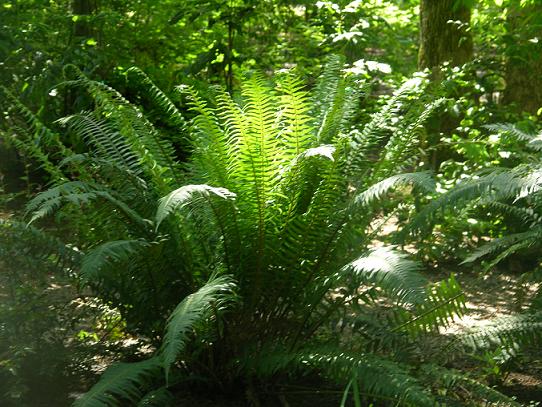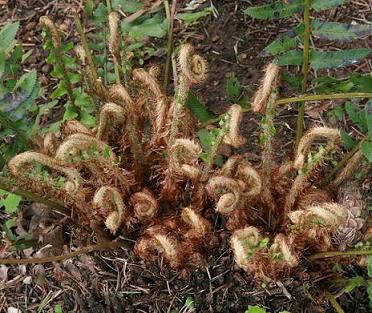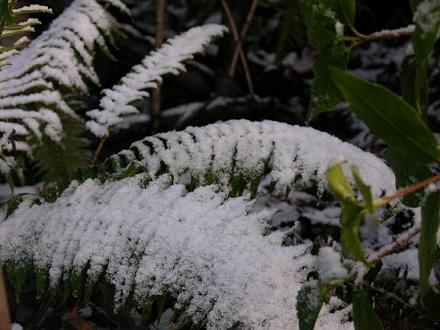|
|
|
Hansen's Northwest Native Plant Database |
|
|
|
Polystichum munitum (Sword Fern,
Christmas Fern, Sword Holly Fern)
A fully mature Sword Fern kissed by the morning sun. |
 |
||||||||||||||||||||||||
|
Plant Brief: A magnificent evergreen fern, the Sword Fern is the centerpiece of the native garden. The long-time darling of flower arrangers the world over, Sword Fern is a must for every cut-flower enthusiast. Sword Fern forms massive clumps with fronds 2-5’ in length. These perfectly symmetrical fronds grow erect or arch slightly. Large clumps can have up to 100 fronds and are stunning. Sword Fern is found in shaded locations from Alaska to California and east through the Rocky Mountain ranges (USDA 7-10). It is a long-lived fern and is not susceptible to damage by deer. Natives used the fronds as bedding or to line berry baskets and steaming pits. The rhizome was eaten in emergencies. |
|||||||||||||||||||||||||
| The following article was written by Julie Rasmussen of Portland, Oregon, in August 2002. | |||||||||||||||||||||||||
|
Description: If you have ever ventured into the forests of the Pacific northwest, then you have surely seen the magnificent Sword Fern. It is so common throughout the forests in its range, that if there is a tree overhead, chances are there is a Sword Fern nearby. Often they share the shady forest floor with mosses and groundcovers, but sometimes you will find them creating a thick, rich carpet all by themselves. Instead of displaying flowers or colorful fall foliage, the Sword Fern offers a lush and grand landscape full of texture and color year-round. A single Sword Fern can provide a sophisticated accent to a shady oriental style garden, or several of them, alone or combined with other woodland plants, can bring the northwest forest to your own corner of the world. |
|||||||||||||||||||||||||
|
The Sword Fern is a beautiful and long-lived evergreen fern that can become four feet tall and seven or eight feet wide in ideal conditions. However, it is more likely to grow to two or three feet tall and four to six feet wide. In a mature plant, as many as 100 dark-green, lance-shaped fronds may grow from the rhizome at the plant’s center. In early spring, the young fronds, or fiddleheads, appear and begin to slowly unroll. Each frond may reach four to six feet long and will live for several years. The fronds are comprised of many simple, alternate leaflets, or pinnae. These leaflets are finely serrated and have clusters of brown spore cases, called sori, on their undersides. When fully shaded, the Sword Fern will take on a wonderful spreading nature as the fronds arch outward from the central clump. In a sunnier position, the plant is more upright with shorter, erect fronds and almost overlapping leaflets. The structure of a young Sword Fern is like that of a mature plant, but they have a more crinkly appearance. |
 Early spring fiddleheads rising from the trimmed fronds from previous years. Such manicure treatment is always appropriate in early spring if desired. |
||||||||||||||||||||||||
|
Habitat and Range: The Sword Fern can be found growing along the western coast of North America from the Yukon Territory and southeastern Alaska south to Santa Barbara County, California and east through Washington and northern Idaho into northwest Montana. It grows between sea level and mid-elevation. Outside of this area, two separate populations of sword ferns have been found, one in South Dakota and the other on Guadalupe Island, off Baja California. The Sword Fern will reach its grandest proportions under classic fern conditions - moist, loamy soil with nearly full shade. However, it does quite well in dry shade, part shade, and in soil with low to moderate nutrient levels. The Sword Fern prefers year-round moisture, but once established, the deep and fibrous roots make it quite drought resistant, especially when shaded. |
|||||||||||||||||||||||||
|
The Sword Fern is an understory plant in coniferous and mixed forests. In the wild, it is commonly found with the following plants: Vine Maple (Acer circinatum), Salal (Gaultheria shallon), Twinflower (Linnaea borealis), Cascade Oregon Grape (Mahonia nervosa), False Lily-of-the-Valley (Maianthemum dilatatum), Rusty Menziesia (Menziesia ferruginea), Western Springbeauty (Montiasibirica), Wood Sorrel (Oxalis oregona), Thimbleberry (Rubus parviflorus), Salmonberry (Rubus spectabilis), Threeleaf Foamflower (Tiarella trifoliata), Red Huckleberry (Vaccinium parvifolium), Evergreen Huckleberry (Vaccinium ovatum), Evergreen Violet (Viola sempervirens), Pioneer Violet (Viola glabella). Native Plant Gardening: The Sword Fern is a beautiful, flexible and very low maintenance addition to the garden. It is appropriate for USDA zones 3-8. Sword Ferns will brighten even the darkest corners with a year-round lush green color. |
A common sight in northwest woods, Sword Fern will populate bare spaces in the landscape. |
||||||||||||||||||||||||
|
Try planting them on their own, in combination with other native ferns, such as the Deer Fern (Blechnum spicant), or with some of the plants mentioned above. Nothing communicates the peace and serenity of the forest like a Sword Fern growing from a fallen moss-covered log! Dead fronds should be left attached to the plant through the winter and then removed, if desired, in February, just prior to the appearance of new growth. Wildlife Habitat: Sword Ferns provide cover for wildlife, and serve as a host plant for some butterflies. Elk, deer, black bears and mountain beavers forage on the fronds. |
|||||||||||||||||||||||||
|
Historical and Cultural Uses*: Native Americans used nearly every part of the sword fern. Because of their non-stick qualities, the fronds were used on berry-drying racks, to separate food in storage, and to line baking pits. They were also piled for use as mattresses. The young curled fronds were chewed to sooth sore throats, and Lummi women chewed them to hasten childbirth. Some tribes ate the rhizomes of the Sword Fern. They were dug in the spring, peeled and roasted over a fire or steamed in a baking pit, and served with fresh or dried salmon eggs. The cooked rhizomes were also eaten to cure diarrhea. The Quinaults boiled the roots in water and used the water as a treatment for dandruff. *Please use caution when preparing or eating any parts of a plant. Identification of the species and knowledge of a plant’s toxicity are both essential before using any plant species medicinally or otherwise. Please consult with a heath professional before attempting to treat any ailment. |
 This hardy specimen barely gave the snow a second glance. |
||||||||||||||||||||||||
|
Propagation Techniques: Sword Ferns may be divided in spring if the clump is large and the roots are well developed. Sword Ferns may also be propagated from spores in a process that takes around six months. Collect the spores when mature, usually from July to late August. An easy way to collect the spores is to shake the fronds in a paper bag so the spores are contained when released from the fronds. Sprinkle the spores onto a bed of moistened peat moss, cover with plastic and place in a shady, but not completely dark, location with a temperature between 59 and 86 degrees Fahrenheit. Do not let the container dry out, but do not let mold grow in it either. Wipe away condensation to help prevent this. After several weeks, flat heart-shaped discs, called gametophytes, will appear. Mist with water if they appear dry and be sure to keep them moist. A few weeks later, tiny fern fronds will sprout from the gametophyte, which will eventually wither and die as the fern establishes itself independently. The ferns can be transplanted to individual containers a few weeks after the fronds appear, but take care as they are very fragile. Common Diseases: Sword Ferns are very disease and pest resistant. |
|||||||||||||||||||||||||
|
Photos We Share!
|
|||||||||||||||||||||||||
|